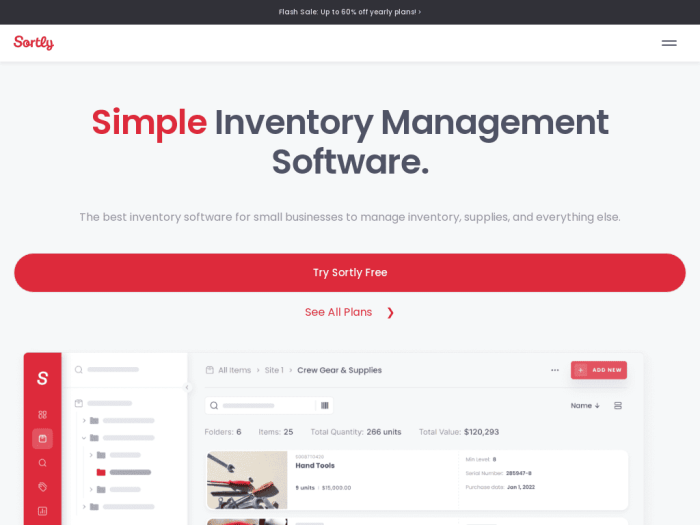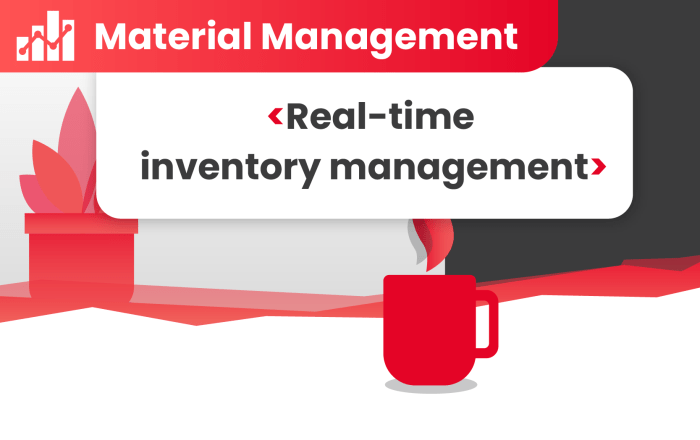Real time inventory software revolutionizes stock management, offering businesses unparalleled visibility into their inventory levels. This allows for proactive decision-making, minimizing stockouts and overstocking. Efficient inventory tracking translates directly to reduced costs, improved operational efficiency, and ultimately, increased profitability. Understanding the capabilities of real-time inventory systems is crucial for businesses of all sizes seeking to optimize their supply chain and gain a competitive edge.
From small retailers to large-scale manufacturers, the benefits are substantial. Features such as automated tracking, real-time data updates, and integrated reporting tools provide a comprehensive overview of inventory flow. This enhanced visibility empowers businesses to make data-driven decisions, leading to more accurate forecasting and better resource allocation. Moreover, integration with other business systems, such as point-of-sale (POS) systems and enterprise resource planning (ERP) software, further streamlines operations and enhances data accuracy.

Source: meetanshi.com
In today’s fast-paced business environment, efficient inventory management is paramount. Real-time inventory software offers a powerful solution, providing businesses with up-to-the-minute visibility into their stock levels, enabling better decision-making and ultimately boosting profitability. This comprehensive guide delves into the intricacies of real-time inventory software, exploring its features, benefits, and how it can revolutionize your inventory management processes.
Understanding Real-Time Inventory Software
Real-time inventory software, also known as real-time inventory management system (RTIMS) or stock management software, utilizes advanced technologies to track inventory levels dynamically. Unlike traditional systems that rely on periodic updates, RTIMS provides continuous data updates, reflecting the exact stock status at any given moment. This immediate visibility is crucial for optimizing various aspects of the supply chain, from procurement to fulfillment.
Key Features of Real-Time Inventory Software, Real time inventory software
- Automated Data Capture: Integration with barcode scanners, RFID readers, and other data capture devices ensures accurate and automatic data entry, minimizing manual errors.
- Centralized Database: A single, unified database provides a comprehensive view of inventory across multiple locations, warehouses, or even online marketplaces.
- Real-Time Stock Level Tracking: The core function – providing instantaneous updates on stock levels, allowing businesses to react swiftly to changes in demand.
- Low Stock Alerts: Automated alerts notify users when stock levels fall below predefined thresholds, preventing stockouts and ensuring timely replenishment.
- Demand Forecasting: Sophisticated algorithms analyze historical data and predict future demand, enabling proactive inventory planning.
- Inventory Optimization: Features that help optimize stock levels, minimizing storage costs and reducing waste.
- Reporting and Analytics: Comprehensive reports and dashboards provide insights into inventory performance, helping identify areas for improvement.
- Integration with Other Systems: Seamless integration with ERP, POS, and e-commerce platforms streamlines operations and improves data flow.
- User-Friendly Interface: Intuitive dashboards and user-friendly interfaces ensure easy access and utilization by all staff members.
- Mobile Accessibility: Access inventory data anytime, anywhere through mobile apps.
Benefits of Implementing Real-Time Inventory Software
The advantages of adopting real-time inventory software extend across various aspects of a business. Here are some key benefits:
- Reduced Stockouts: Real-time visibility prevents stockouts by triggering alerts when stock levels are low, ensuring customer satisfaction and preventing lost sales.
- Improved Order Fulfillment: Accurate inventory data ensures faster and more efficient order processing and fulfillment.
- Optimized Inventory Levels: Demand forecasting and inventory optimization features minimize excess inventory, reducing storage costs and minimizing waste.
- Enhanced Customer Service: Accurate stock information empowers staff to provide customers with reliable delivery estimates and handle inquiries efficiently.
- Increased Profitability: By reducing stockouts, minimizing waste, and optimizing operations, real-time inventory software contributes directly to increased profitability.
- Better Decision-Making: Data-driven insights facilitate informed decision-making regarding procurement, pricing, and marketing strategies.
- Streamlined Operations: Automation of tasks and seamless integration with other systems streamline workflows and improve overall operational efficiency.
- Reduced Labor Costs: Automation reduces the need for manual data entry and reconciliation, freeing up staff for other tasks.
- Improved Accuracy: Automated data capture minimizes human error, leading to more accurate inventory data.
- Better Inventory Control: Gain complete control over your inventory, minimizing shrinkage and theft.
Choosing the Right Real-Time Inventory Software
Selecting the appropriate real-time inventory software requires careful consideration of your specific business needs and requirements. Factors to consider include:
- Business Size and Complexity: Choose software that scales with your business’s growth and complexity.
- Industry-Specific Features: Some software solutions offer industry-specific features tailored to particular needs (e.g., retail, manufacturing, wholesale).
- Integration Capabilities: Ensure seamless integration with existing systems (ERP, POS, e-commerce platforms).
- Scalability and Flexibility: Choose software that can adapt to your changing business needs.
- Cost and Pricing Models: Consider various pricing models (subscription-based, one-time purchase) and their associated costs.
- Vendor Support and Training: Reliable vendor support and comprehensive training are crucial for successful implementation.
- Security and Data Protection: Prioritize software with robust security measures to protect sensitive inventory data.
Implementing Real-Time Inventory Software: Real Time Inventory Software
Successful implementation requires careful planning and execution. Key steps include:
- Needs Assessment: Clearly define your inventory management challenges and objectives.
- Software Selection: Carefully evaluate different software solutions based on your needs and requirements.
- Data Migration: Migrate existing inventory data to the new system accurately and efficiently.
- Training and Support: Provide adequate training to staff and ensure access to ongoing vendor support.
- Integration with Existing Systems: Integrate the software with other systems to ensure seamless data flow.
- Testing and Optimization: Thoroughly test the system and optimize its performance based on feedback.
- Ongoing Monitoring and Maintenance: Regularly monitor system performance and conduct necessary maintenance.
Frequently Asked Questions (FAQ)
- Q: What is the difference between real-time and periodic inventory systems?
A: Real-time systems provide continuous updates, while periodic systems rely on infrequent manual updates, leading to potential inaccuracies and delays. - Q: How much does real-time inventory software cost?
A: Costs vary widely depending on features, scalability, and vendor. Expect a range from affordable cloud-based solutions to more expensive enterprise-level systems. - Q: How long does it take to implement real-time inventory software?
A: Implementation time depends on the complexity of the system and the size of the business. It can range from a few weeks to several months. - Q: What are the key metrics to track after implementing real-time inventory software?
A: Key metrics include inventory turnover rate, stockout rate, order fulfillment time, and inventory accuracy. - Q: Can real-time inventory software integrate with my existing ERP system?
A: Many real-time inventory systems offer seamless integration with various ERP systems. Check with the vendor to confirm compatibility.
References
While specific software recommendations are avoided to remain unbiased, research reputable software review sites and consult with industry experts for vendor recommendations. Look for reviews and case studies on sites such as Capterra, G2, and Software Advice. These resources often provide detailed comparisons and user feedback.
Conclusion
Real-time inventory software is a powerful tool for businesses seeking to optimize their inventory management processes. By providing real-time visibility, automating tasks, and enhancing decision-making, it contributes significantly to increased efficiency, reduced costs, and improved profitability. Investing in the right real-time inventory software is a strategic move that can significantly impact your business’s bottom line.
Call to Action
Ready to transform your inventory management? Explore available real-time inventory software solutions today and take the first step towards a more efficient and profitable future!
In conclusion, implementing real time inventory software presents a significant opportunity for businesses to optimize their inventory management processes. By providing accurate, up-to-the-minute data, these systems empower businesses to make informed decisions, reducing waste, improving efficiency, and ultimately boosting the bottom line. The investment in such technology represents a proactive step towards a more streamlined and profitable future.

Source: theobald-software.com
The ability to react swiftly to changing market demands and customer needs is a key advantage in today’s dynamic business environment, and real-time inventory software is a critical component in achieving this agility.
Expert Answers
What are the different types of real-time inventory software?
Software options range from cloud-based solutions to on-premise systems, each with varying features and pricing models. The best choice depends on specific business needs and technological infrastructure.
How much does real-time inventory software cost?
Pricing varies significantly based on features, scalability, and vendor. Subscription-based models are common, with costs often dependent on the number of users and data storage needs.
How can I integrate real-time inventory software with my existing systems?
Many systems offer API integrations with POS, ERP, and other business software. Consult with your software provider to determine compatibility and integration options.
What security measures are in place for real-time inventory data?
Reputable providers employ robust security protocols, including data encryption and access controls, to protect sensitive inventory information.
What training is required to use real-time inventory software?
Training needs vary depending on the complexity of the software. Many providers offer online tutorials, documentation, and customer support to assist users.
